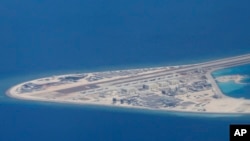Leaders from 10 Southeast Asian countries at this week’s Association of Southeast Asian Nations (ASEAN) summit in the Philippines have sidestepped criticizing China over its expansion in the contested South China Sea, a sign, some analysts say, of Beijing’s economic and diplomatic influence.
ASEAN heads of state who conclude the four-day summit in Manila Saturday have, so far, issued no criticism of China. Analysts and media reports earlier in the week expected a mildly worded statement without naming any one country as a troublemaker.
Nothing provocative
Any slight against China, such as a reminder that it lost a world court arbitration ruling July 12 over the legal basis for its claim to 95 percent of the sea, would be “unnecessarily provocative,” said Collin Koh, maritime security research fellow at Nanyang Technological University in Singapore.
“Most of those statements related to such sensitive issues like the South China Sea tend to be very general and wouldn’t go down to specifics, even including highlighting any particular country as singled out for some kind of reprimand in the statement,” Koh said.
Hesitation to criticize China shows the impact of Beijing’s aggressive negotiations with individual Southeast Asian countries and offers of economic benefits since the arbitration ruling. China’s coast guard activity, land reclamation work and construction of military bases in the 3.5 million-square-kilometer area have previously caused alarm.
“Maybe they’ll say something about self-restraint on the Korean Peninsula, but not much to say about the South China Sea,” said Termsak Chalermpalanupap, a fellow with the ISEAS Yusof Ihsak Institute in Singapore who specializes in maritime security. “The scene is quieter now.”
ASEAN’s statements seldom implicate other countries, and the bloc includes staunch China allies, such as Cambodia and Laos. Philippine President Rodrigo Duterte, this year’s ASEAN chairman, said this week the summit would avoid mentioning the world court arbitration ruling, which China has called a “farce.”
Aid around the region
Since July, China has opened talks with the Philippines, the country that filed for arbitration, and offered it $24 billion in economic aid. China has stepped up discussions on maritime cooperation with Vietnam, another vocal anti-China country before the court ruling. Malaysia already counts China as its top source of investment and trade, and Beijing was working with Brunei on a joint port venture and increased trade cooperation before the world court ruling.
The South China Sea exclusive economic zones of Brunei, Malaysia, the Philippines and Vietnam — all ASEAN members — overlap Beijing’s claims. Taiwan also calls the sea its own. The waters are prized for abundant fisheries as well as undersea gas and oil reserves.
U.S. President Donald Trump has not made it clear whether he will help Southeast Asia resist China’s maritime expansion.
“The Trump administration really hasn’t addressed the South China Sea,” said Carl Thayer, emeritus professor of politics at The University of New South Wales in Australia. “This is a time for China to push ahead with the diplomatic side, so it can consolidate its presence any time it wants. China will pick up the slack here, push the diplomacy.”
Over the past decade China has quickly expanded into the sea, landfilling more than 3,000 hectares to make reefs buildable. It is finishing naval, air, radar and other facilities on three islets in the sea’s Spratly archipelago, according to a program under the Washington-based think tank Center for Strategic and International Studies.
Southeast Asian countries will eventually face off with China over a maritime code of conduct, analysts believe. China has broken six years of resistance by agreeing to work with ASEAN on a framework maritime code by June. The aim of the code would be to prevent accidents at sea without touching on sovereignty disputes.
Developing the framework into a full code would require sensitive talks on whether the code would apply to Chinese-controlled islets, whether Taiwan as a non-ASEAN member would follow it and to what extent the contents are legally binding. China and Southeast Asian might work on those details next year, analysts say.
“The framework is mainly just a skeleton of the document,” Chalermpalanupap said. “(China) wants to be seen as cooperating and that’s why they promised a framework by June this year, but after that we still have to flesh out the skeleton. That will involve a lot of discussion.”









